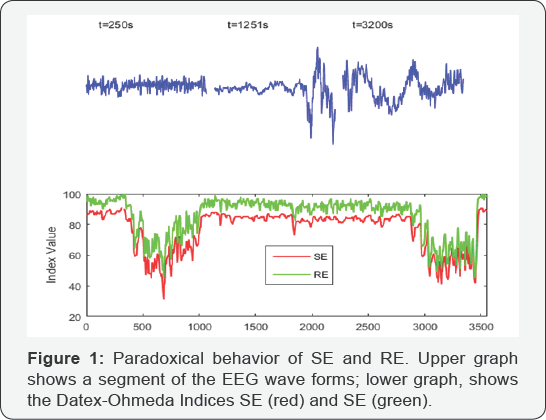Monitoring the Depth of Anesthesia and Current Technology-Juniper Publishers
Juniper Publishers-Journal of Anesthesia
Introduction
General anesthesia (GA) is defined as a drug-induced
loss of consciousness during which patients are not arousable, even by
painful stimulation [1].
GA takes an important role in surgical procedures where an anesthetic
overdose may lead to drug-associated toxicities, coma and even death; on
the other hand a light anesthetic dose may lead to the well-known event
of intraoperative awareness, which can cause sleep disorders,
depression, night terrors, hospitals fears and post-traumatic stress
disorder [2-4]. In this context, monitoring depth of anesthesia has become an important issue in anesthesiology.
Electroencephalographic signal (EEG) reflects the
activity of the central nervous system and it has been widely used for
monitoring depth of anesthesia. In general terms, the EEG of an
anesthetized patient changes from high frequency, low amplitude when
awake to low frequency, high amplitude when anesthetized; it is also
noted that, during the anesthesia procedure the degree of EEG disorder
is reduced. Therefore, the concept of entropy was introduced in EEG
signal processing. Entropy is related to the complexity of a signal, and
has been considered a promising measure of states of consciousness [5]. State Entropy (SE) and Response Entropy (RE) are indices provided by Datex-Ohmeda S/5TM entropy module (General Electric, Finland), which is currently a reference in EEG monitoring during general anesthesia [6,7].
SE and RE are based on spectral entropy computation over the Fourier
spectrum; a description of the algorithm applied is available elsewhere [8].
The M-Entropy module is considered a reference in monitoring the depth
of anesthesia based on EEG analysis, particularly the Response Entropy
(RE) index, was considered a better predictor of patient response to
painful stimuli than the Bispectral index (BIS) [9] .
Brain electrical activity indices provide an a
dimensional number. Generally, a value between 40 and 60 is associated
with an appropriate depth of anesthesia, higher values are associated
with an awake patient and lower values with a very deep anesthesia.
Although this information is useful, it should be used carefully, there
could be cases in which the monitor may provide a paradoxical behavior,
the next section introduce a report of a paradoxical cases identified at
Clinica Universidad de La Sabana when using the Datex-Ohmeda indices.
EEG monitor and paradoxical behavior
There was a case in which the current technology (SE,
RE) provide a parodoxical behaviour that did not match with the
clinical assesment. A 49 years-old female patient, with procedure
hysteroscopy and endometrial biopsy. In this case SE and RE show high
values associated with an awake patient during the surgery (Figure 1).

Automatic impedance test from Datex-Ohmeda monitor
showed no problem; this paradoxical behavior alerts the anesthesiology
to increase doses of propofol from 2.5 to 3.0 mg.ml-1 and
remifentanyl from 5.0 up to 7.0 ng.ml-1 at 1080s. After three minutes of
the same paradoxical behavior, Datex- ohmeda indices were still
inconsistent with the apparent state of the patient. The clinician
decided to discarded SE and RE indices information for the rest of the
procedure and based the decisions on standard monitoring and clinical
assessment. Patient was followed-up by a phone interview 3 and 10 days
after the procedure, no sign of dreams, intraoperative awareness or
recall was reported.
A possible explanation for the paradoxical behaviour
of Datex- ohmeda indices could be a failure to detect the interspersed
low amplitude with high amplitude EEG pattern observed in upper graph of Figure 1,
this pattern could be misinterpreted as a contaminated awake EEG
resulting in a paradoxical increase in SE and RE, it can be observed
that the signal reveals the burst supression pattern. Datex ohmeda
indices return to a value associated with clinical state of the patient
(40-60) 350s after the TCI was suspended at 2670s, and the EEG alpha
spindles pattern becomes more clear.
Conclusion
In conclusion, there are cases in which current
technology could misinterpreted EEG patterns. If the anesthesiologists
are not aware of this situation, is likely that they deepen what is
already deep anesthesia.It is important to realize that unexpectedly
high quantitative EEG indices values are relatively common and may
result in dangerous anesthetic drug overdose [10].
For more articles in Journal of Anesthesia
& Intensive Care Medicine please click on:
https://juniperpublishers.com/jaicm/index.php
https://juniperpublishers.com/jaicm/index.php
Comments
Post a Comment